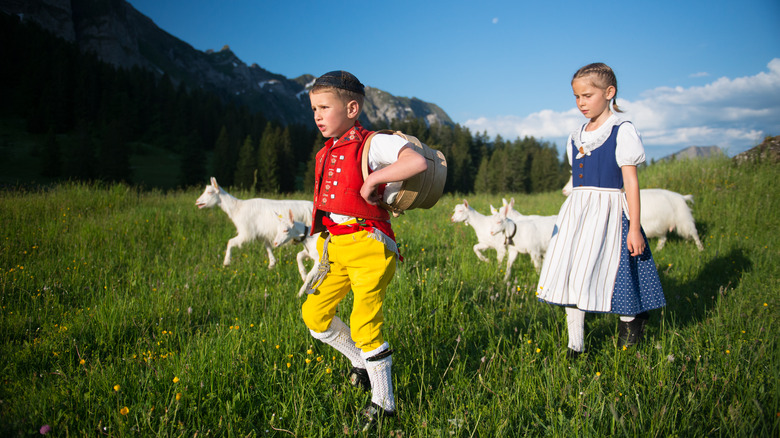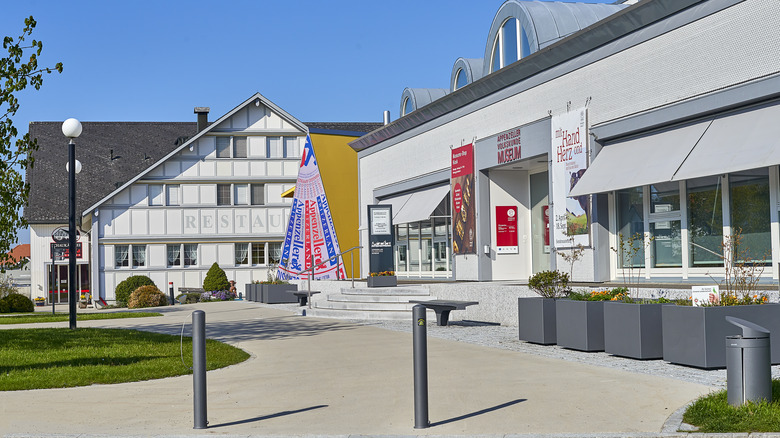You know you’re in true cattle country when the all-too-familiar sounds of yodeling and cowbells can be heard from anywhere. Nestled in northeast Switzerland, Appenzell is one of the smallest cantons in the Swiss Alps, and this enchanting alpine town looks like a village straight out of a fairytale. Perched atop the hillsides at an elevation of 5,000 feet, the mountainous terrain is blanketed in rolling green hills throughout spring and summer before transforming into a scene of icy Alps in the winter.
This mountaintop hamlet also happens to be one of Rick Steves’ favorite Swiss villages, which he described as a town with “the best cow culture in the Alps” on his website. Appenzell embraces age-old traditions often forgotten by the rest of this Swiss region. Many parts of Appenzell’s culture remain stuck in the past, and this alpine village is slow to catch on to modern practices. According to Steves, locals still gather in the town square to vote, and women were discouraged from participating in local votes until 1990. However, the heart of this town’s culture can be seen grazing peacefully on the verdant plains. The ratio of cows to humans is astounding, to say the least. According to The Straits Times in 2016, there were more than 15,000 cows and 15,700 residents. Contrary to popular belief, cow culture in Appenzell consists of more than just a chunk of fresh Appenzeller cheese. Cattle drives and cow parades are as much a part of Appenzell’s heritage as its cheesy local delicacy.
Embracing cow culture in Appenzell

Cattle drives aren’t just an entertaining spectacle atop the Swiss Alps — they symbolize an important mile marker in a farmer’s annual season of work. This great Appenzell migration takes place around May-June and again in August-September, with exact dates dependent on weather conditions. Cattle drives are a sacred ritual in this town, as in many other rural alpine regions. Fresh herbs and grass tend to thrive on the high mountain plains during the warmer days of the year, encouraging farmers to herd their cattle to higher elevations in search of plentiful food for their livestock. They return to the valley in autumn when the grass on the verdant plains no longer serves as a plentiful source of food. Rainy conditions may mean the farmers begin their descent as early as August, but optimal conditions cause the fall cattle drive to take place as late as mid-October.
This highly-anticipated event often begins in the middle of the night, parading through the streets in a frenzy of clanking cowbells, rambunctious cattle dogs, and a festive musical montage led by a group of yodellers. At the head of the group is the Gässbueb (the goat boy), followed by a young goat girl and a herd of white goats trailing swiftly behind. When the cows come home (literally) every autumn, the town holds an annual cattle show, rewarding the winning cows with flower crowns. The herd is separated into categories and judged respectively on appearance and performance by the town’s most seasoned farmers.
Wake up and smell the cheese in Appenzell

This cow-happy village loves their alpine cheese just as much as they do their four-legged farmyard friends. According to the Institute of Culinary Education, alpine cheese is characterized by a distinctive flavor rooted in the practice of herding, where cows are moved from their grazing land to higher elevations in the spring. The collection of herbs, flowers, and other edible substances found on these higher plains results in a unique flavor note among alpine cheeses. Appenzeller cheese is among some of the most famous alpine cheeses, and the art of cheesemaking is an integral piece of this town’s food culture. Appenzeller cheese has been a local staple cultivated in this Swiss region for over 700 years, and it’s said to be the country’s spiciest and most pungent cheese.
Appenzell showcases its legendary cheesemaking processes at the Appenzeller show dairy, the cheese factory behind the magic of this cultural craft. Cheese lovers can eat their way around the enormous factory, with tours revealing the secrets behind the history, branding, and cultivation of their native cheese. While locals are never hesitant to eat this aromatic cheese on its own, it’s common to serve it in a local dish called kasehornli, Appenzell’s innovative take on macaroni and cheese. Appenzell cheese, apple sauce, and Swiss white beef sausage is also a common pairing. As Rick Steves describes, “When locals are asked about Appenzell cheese, they clench their fists as they answer, ‘It’s the best.'”

